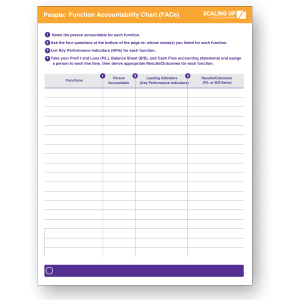Accountability gaps are one of the most common — and costly — issues in growing businesses.
When no one owns the outcome, everyone feels the pain.
As your business grows, the need for clarity around roles becomes non-negotiable. At Coaching 360, we help scaling companies build leadership structures that work — and one of the most common issues we fix is accountability gaps.
These are areas of the business where:
- No one is truly accountable
- Multiple people think they own the same thing
- Critical functions are simply missing
In this guide, we’ll show you how to spot accountability gaps before they stall your growth — and what you can do to close them.
What Is an Accountability Gap?
An accountability gap is a blind spot where no one in the business is fully accountable for a critical function, outcome, or process. The work might be happening, but there’s no clear owner.
It’s the difference between someone doing the thing and someone owning the result.
When you don’t have true accountability:
- Projects get delayed or dropped
- Goals are missed or misunderstood
- Leadership meetings go in circles
- Founders get dragged into every decision
This is where the Functional Accountability Chart (FACe) comes in.
5 Signs You’re Missing a Key Business Function
Here are the most common signals we see in scaling teams:
1. You’re Constantly Firefighting
If your leadership team is always in reactive mode, chances are some functions don’t have clear ownership.
2. No One Owns ‘People’
Hiring, onboarding, culture, retention — who owns this? If “HR” is an afterthought, that’s a structural issue.
3. Marketing Is a Collective Guess
You’re producing content, posting on LinkedIn, maybe running ads — but who’s accountable for ROI?
4. Customer Success Is Everyone’s Problem
When clients churn or complain, does it bounce between delivery, sales and support? That’s a red flag.
5. You Don’t Have a Chart That Shows Ownership
If your org chart is based on job titles instead of business functions and outcomes, you’re likely flying blind.
How to Fix Accountability Gaps
Step 1: Map Core Business Functions
Start with a list like:
- Sales
- Marketing
- Operations / Fulfilment
- Finance
- People / HR
- IT / Systems
- Customer Success
- Strategy / CEO
Step 2: Build Your Functional Accountability Chart
Assign one accountable person per function. No committees. Use our free FACe template to get started.

Scaling Up’s Function Accountability Chart (FACe). Digital Download available below.
Step 3: Define Responsibilities and KPIs
Get specific. What does “owning Marketing” mean? Leads? Conversion rate? Campaign ROI?
Step 4: Review Quarterly
As you scale, roles evolve. Update your chart to reflect the business you’re becoming.
Final Thought: Gaps Don’t Fix Themselves
If you’ve been feeling like your team is overworked but under-aligned — there’s probably an accountability gap underneath it. Decisions around People is one of the Four Big Decisions that a Scaling Business Owner needs to make.
Structure isn’t restrictive. It’s liberating.
The right chart gives your team permission to own outcomes without stepping on each other’s toes.
Want help mapping your accountability structure? Talk to Coaching 360
FAQ: Spotting Accountability Gaps
What’s the difference between a job description and a function?
Job descriptions focus on tasks. Business functions focus on outcomes. One person may do many tasks, but functions need clear owners.
How do I know if we have a gap?
If you keep having repeat issues in a certain area — but no one takes ownership — that’s a gap. Another sign: leadership arguments over “who owns what.”
What’s the solution?
Use a Function Accountability Chart to map ownership. It’s simple but powerful. Download our free guide to start.
What if we’re a small team?
Even in a 3–5 person business, structure matters. You may wear multiple hats — but each hat still needs to be clearly labelled.

